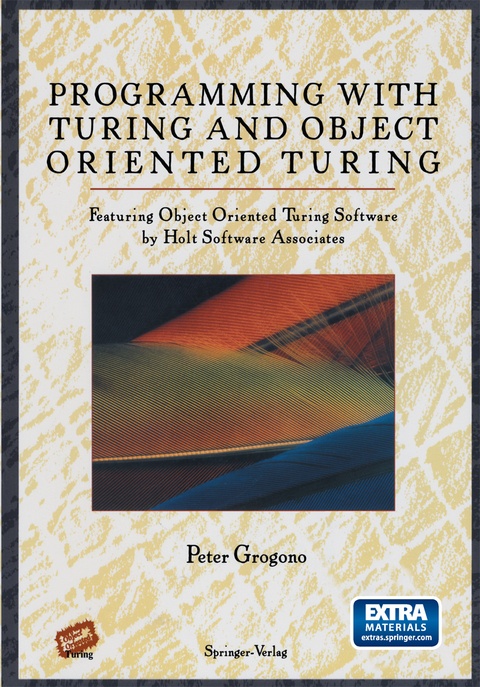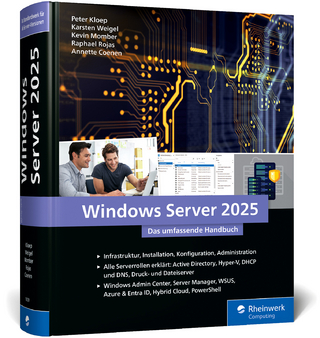
Programming with Turing and Object Oriented Turing
Springer-Verlag New York Inc.
978-0-387-94517-0 (ISBN)
The programming language Thring is Damed for the British mathematician and computer scientist Alan Mathison 'lUring (1912-1954). Thring's contributions to computer science began in 1936, when he published a landmark paper on the limits of mechanical computation. The mathematical model introduced in the paper is now known as a unuing machine" and forms the basis of the modern theory of computability. During World War II, Thring played an important role in the design of the Colossus, an electronic machine that deciphered. coded messages. In 1951, he proposed a test, now called the Thring test, to answer the question: Can a machine think? Today, the most distinguished award given by the world's largest association for computing professionals, the Association for Computing Machinery, is called the Thring Award. The programming language Thring was designed by Richard C. Holt and James R. Cordy at the University of Toronto as a first language for computer science courses. Thring is a practical language suited to general-purpose applications.
1 First Concepts.- 1.1 Writing Simple Programs.- 1.2 Learning to Read Programs.- 1.3 Introduction to Standard Types.- 1.4 Declarations.- 1.5 Output and Input.- 1.6 Comments.- 1.7 Summary.- 1.8 Exercises..- 2 Assignment and Control.- 2.1 The Assignment Statement.- 2.2 Sequences.- 2.3 Decisions.- 2.4 Repetition.- 2.5 Scopes and Local Declarations.- 2.6 The Form and Content of Statements.- 2.7 Summary.- 2.8 Exercises.- 3 Standard Types and Expressions.- 3.1 The Role of Types in Programs.- 3.2 The Typesint and real.- 3.3 The Type boolean.- 3.4 The Type string.- 3.5 Type Conversion.- 3.6 Summary.- 3.7 Exercises.- 4 Defining New Types.- 4.1 Subranges.- 4.2 Enumerations.- 4.3 Arrays.- 4.4 Summary.- 4.5 Exercises.- 5 Procedures and Functions.- 5.1 Predefined Procedures and Functions.- 5.2 Declaring New Procedures.- 5.3 New Functions.- 5.4 Recursive Subprograms.- 5.6 Rules for Subprograms.- 5.7 Preconditions and Postconditions.- 5.8 Summary.- 5.9 Exercises.- 6 Input and Output.- 6.1 Managing the Keyboard.- 6.2 Managing the Screen.- 6.3 Text Files.- 6.4 Summary.- 6.5 Exercises.- 7 Sound and Graphics.- 7.1 Sound.- 7.2 Graphics.- 7.3 Animation.- 7.4 Summary.- 7.5 Exercises.- 8 Sets, Records, and Unions.- 8.1 Sets.- 8.2 Records.- 8.3 Unions.- 8.4 The bind Statement.- 8.5 Summary.- 8.6 Exercises.- 9 Collections.- 9.1 Prom Arrays to Collections.- 9.2 Linked Lists.- 9.3 The new and free Statements.- 9.4 Collections and Recursion.- 9.5 Designing a Symbolic Calculator.- 9.6 Summary.- 9.7 Exercises.- 10 Organizing Large Programs.- 10.1 Modules.- 10.2 The include Directive.- 10.3 Summary.- 10.4 Exercises.- 11 Additional Features.- 11.1 Binary Files.- 11.2 Subprogram Arguments.- 11.3 Summary.- 11.4 Exercises.- 12 Object Oriented Turing.- 12.1 Classes and Objects.- 12.2 Inheritance.- 12.3 Frameworks.- 12.4 Ancestors and Descendants.- 12.5 Summary.- 12.6 Exercises.- Appendixes.- A Turing Keywords.- B Expression Operators.- C Assignment Operators.- D Predefined Functions and Procedures.- E Codes for the ASCII Graphic Character Set.- F ASCII Codes for Border Characters.- J Colors for the IBM PC and Compatibles.- K Installing WinOOT.- L Running WinOOT.- Index 379.
| Zusatzinfo | XV, 392 p. |
|---|---|
| Verlagsort | New York, NY |
| Sprache | englisch |
| Maße | 178 x 235 mm |
| Themenwelt | Informatik ► Betriebssysteme / Server ► Windows |
| Mathematik / Informatik ► Informatik ► Programmiersprachen / -werkzeuge | |
| Informatik ► Software Entwicklung ► Objektorientierung | |
| Informatik ► Theorie / Studium ► Compilerbau | |
| ISBN-10 | 0-387-94517-2 / 0387945172 |
| ISBN-13 | 978-0-387-94517-0 / 9780387945170 |
| Zustand | Neuware |
| Informationen gemäß Produktsicherheitsverordnung (GPSR) | |
| Haben Sie eine Frage zum Produkt? |
aus dem Bereich


